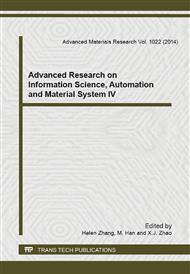p.286
p.292
p.296
p.300
p.304
p.311
p.316
p.321
p.325
Information Processing with Combination Method for Dependent Evidences Based on Principal Component Analysis
Abstract:
To meet the requirement that evidences must be independent for evidences combination in D-S evidence theory when the information processing, the dependence among evidences should be eliminated, so a new combination method of dependent evidences based on the Principal Component Analysis (PCA) is presented. The high-dimensional dependent evidences are replaced by the new low-dimensional independent evidences to reduce the dimensions following the guiding rule of PCA, and then the probability under the new evidences is calculated. The new independent evidences are combined with the combination rules of D-S evidence theory. Compared to existed methods, the dependence in initial evidences is eliminated, and the number of evidences is reduced, which leads to the simplification of the process of evidence combination. Finally, an example is employed to verify the feasibility and effectiveness of the proposed approach.
Info:
Periodical:
Pages:
304-310
Citation:
Online since:
August 2014
Authors:
Keywords:
Price:
Сopyright:
© 2014 Trans Tech Publications Ltd. All Rights Reserved
Share:
Citation:


